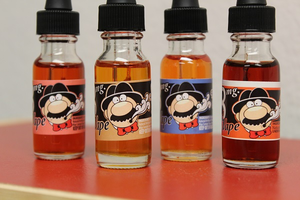Liquid Nicotine Companies Co-Opt Popular Candy and Cereal Brands to Target Kids
The efforts of the traditional tobacco industry to market cigarettes to kids has been well documented. In the 1960s and ’70s, tobacco companies advertised during popular kids shows like The Flintstones, put cigarette-shaped sweets on the market, and even created the character Joe Camel to appeal to youth. Now cigarette advertising is heavily regulated by government agencies.
But with the rise of e-cigarettes comes a new way to entice kids with nicotine, and companies are jumping at the chance, illegally branding their wares with the same names, packaging, logos, and colors as popular candy and children’s cereal brands such as Cinnamon Toast Crunch and Hershey’s.
While conventional cigarettes pose a long-term health risk, the liquid nicotine used in e-cigarettes is incredibly dangerous to young kids: A mere 1 teaspoon of concentrated liquid nicotine can prove to be fatal when ingested by toddlers and small children.

A newly released report from the bipartisan child welfare lobbying group First Focus found that poison control centers reported a 1,296 percent increase in exposure to liquid nicotine from 2011 to 2014, with more than half of those incidents involving children under the age of 6.
And the five brand names most commonly used by unregulated liquid nicotine manufacturers, the report found, were Skittles, Swedish Fish, Juicy Fruit, Jolly Rancher, and SweeTarts.
The 2014 death of 18-month-old Eli James Hotaling, a toddler living in upstate New York, was the first recorded death of a child after accidentally swallowing the toxic ingredients used to refill e-cigarettes, according to Safe Kids Worldwide. Eli began convulsing and was pronounced dead at his local emergency room due to cardiac arrhythmia induced by nicotine ingestion.
“The lack of federal regulation of e-cigarettes has created a ‘Wild West’ where children’s favorite cereal spokescharacters are now selling them tobacco,” says First Focus president Bruce Lesley. “The fact that so many e-cigarette retailers have gotten away with this proves that the federal government isn’t paying enough attention.”
And it’s not only younger children who are at risk. The CDC reports that e-cigarette use among middle and high school students tripled from 2013 to 2014. Use of e-cigarettes among high school students was found to have increased in that timespan from 4.5 percent to 13.4 percent, translating to a rise from approximately 660,000 to 2 million students. During the same period, the rate of use for middle school students tripled from 1.1 percent to 3.9 percent — an increase from approximately 120,000 to 450,000 students.
With older children using e-cigarettes at skyrocketing rates, younger children are more likely to come across liquid nicotine at home. Liquid nicotine is easily purchased online, marketed as candy, and packaged to look as such too.
Related: Teenagers Use E-Cigarettes to Vape Marijuana, Study Says

In 2014, new Food and Drug Administration (FDA) rules failed to ban e-cigarette marketing to children. While the new FDA rules did impose a ban on giving away samples of e-cigarette products at youth-centered events such as music festivals and sporting events, along with a ban on the selling of e-cigarettes in vending machines, the overall banning of e-cigarettes to minors is done only on a state-by-state basis — and currently 17 states still allow legal sales of e-cigarettes and liquid nicotine to children.
The FDA regulations contain no restrictions on the marketing of liquid nicotine in child-enticing flavors and also allow for the online sale of e-cigarette products — a combination of easy access to seemingly child-friendly products that can have deadly results.

The recently proposed Child Nicotine Poisoning Prevention Act of 2015 is an attempt to protect children from accidental nicotine poisoning by requiring that bottles of liquid nicotine be childproof — something especially critical when liquid nicotine takes on the appearance of popular candies, snacks, and cereals.

First Focus’s investigation into liquid nicotine marketing also uncovered several brands of liquid nicotine marketing their product as baby food (such as the Earth’s Best brand), utilizing popular cartoon characters such as Winnie the Pooh or, simply, stuffed animals.
“Liquid nicotine retailers aren’t hiding their abusive marketing — they’re advertising it to children right under the noses of candy and cereal companies,” says Lesley. “When regulators and companies don’t crack down on egregious marketing, they’re failing children and families.”
Updated October 7, 2015:
In a statement, a representative for Mars, Inc. said, “Any company using Mars’ brands to sell nicotine, tobacco or vape products is doing so without our permission. Mars does not authorize the use of our brands in this way, and we object to any company using our brands to market nicotine products. We are taking immediate action to stop this unauthorized use of our trademarks.”
Read This Next: Your Body Immediately After Vaping an E-Cigarette

